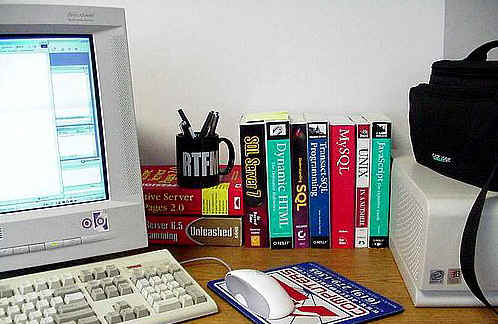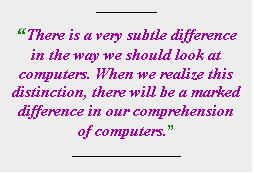|
| Globally, HR has not yet recognized an opportunity that information revolution has given to it on a platter. There is a new role that HR can play in this business world which is changing so rapidly on account of IT. HR has to redicover itself. |
IT,
unlike popular belief, is not all technology. It has a very high people
component. A successful IT implementer has to be a people expert as
much as a technology expert.
There is a big paradox in
businesses today. When IT impacts so many employees and their behaviour, and
businesses have HR departments to look after everything concerning
employees, why is it that no one has thought of a role for HR in IT
implementations? HR itself has been blind to this possibility.
Globally,
HR has not yet recognized an opportunity that information revolution
has given to it on a platter. There is a new role that HR can play in
this business world which is changing so rapidly on account of IT. HR
has to rediscover itself.
IT driven change is impacting people.
People are not comfortable with rapid change and need support to cope
with this change. Who else in the company can understand people
psychology? Which department can understand the psychology of change? Finance? IT?
Production? Obviously it is HR.
IT guys are the guys who drive
this change. They affect the lives and lifestyle (or workstyle in companies) of all
the people. Any change can only be driven by a person who has authority.
Can you imagine a lowly peon trying to bring about a change in
behaviour, and a CEO trying to do it? It is a no brainer to say that
CEO can best drive a change. It is obvious that a person who wields the
authority is best suited to bring about a change in companies.
Here
is another paradox - businesses are full of paradoxes. IT needs to
drive the change but has no authority. The affected parties resist
change and IT can do nothing about it. IT folks' lives depends on the
success of projects or change implementations. But they cannot drive
change or they do not have the authority to push it through. The
affected parties have nothing to lose. They can blame it on IT
(although they do not know how much they loose in terms of efficiency).
But they can certainly save their skin and avoid the discomfort of
change. There is always a conscious desire to improve efficiencies, but
there are also these lurking subconscious desires to save their skin
and to avoid change. Subconscious desires always overpower conscious
desires.
To make matters worse, technology is equally confusing
to most managers. "I just don't understand this technology" is a very
common phrase heard in offices. The CEO, who IT department can look
upon to assist in bringing about a change, is equally confused. Whereas
he is comfortable speaking to and befriending the HR manager, Finance
manager, production manager, etc., he keeps the IT manager at arms
length as he does not understand anything of IT. He is not comfortable
talking to IT folks so he never befriends them. In such a situation,
politics flourishes, as parties involved in automation try to take
advantage of his ignorance. Since today's CEO is more comfortable
dealing with HR than with IT, HR has a great opportunity there to help
the CEO cope with this issue of managing IT Driven change.
HR
has a great role to play. But HR has to first equip itself to play this
role. It needs to first understand the dynamics of this IT Driven
Change. They need to understand what exactly creates this stress and
confusion during IT Implementations. HR can then embrace this new role
of change catalyst and contribute to the company's growth.
IT folks can continue to be the change agents, and HR needs to take on
this new role of a change catalyst.

Why this Seminar?
Benefits for You
 |
Luckily, this special skill has nothing to do with technology, it deals more with mindset and psychological issues - a topic again which HR is best equipped to understand and handle.
Come to discover the new avenues waiting exclusively for HR folks to take up - as there are no other takers. There is a big need for this role to be taken up looking at the amount of failures in IT implementations. A study puts IT Implementations failure to anything between 70-80 % accompanied with heavy loss of hard cash. As if this is not good enough reason for the new role, there is the employee stress, friction, politics and the immense loss of employee efficiency due to this stress.
See
What Participants Say
| View
Brochure | Download
PDF Brochure
What Do You Gain as a Participant
You will know
![]() People and
how they behave
under the impact of changes taking place in your organization due to
automation
People and
how they behave
under the impact of changes taking place in your organization due to
automation
![]() The
characteristics of
information technology itself, some inherent flaws and pitfalls which
makes it
so painful to implement it
The
characteristics of
information technology itself, some inherent flaws and pitfalls which
makes it
so painful to implement it
![]() How to
safeguard against these
pitfalls
How to
safeguard against these
pitfalls
![]() Major
misconceptions which are
the root cause of employee stress, friction between peers and
frustration in
companies.
Major
misconceptions which are
the root cause of employee stress, friction between peers and
frustration in
companies.
Benefits for your Company
Corporates are incurring heavy losses on account of failed implementations - leave alone the opportunity cost and the impact of friction and frustration among senior managers.
Statistics place implementation failures to anything between 60% and 80%. The cost of ERP implementation is not the software cost alone, it includes hardware cost, training cost, cost of senior people's time and most important the consultant fees, which are very high.
The cost of average ERP implementation for a medium to large enterprise with 100 to 250 users is about Rs. 25 million and the total cost of ownership around Rs. 45 million (Source: Aberdeen Group, August 2006). With cost of services having shot up, the cost will be higher.
With average 70% failure rate, you know what to expect. Would you like to only blame it on the IT folks for this failure and wash your hands off or contribute actively and effectively to make it a success? After all computerization success would impact your success more than it would affect the IT folks. After all success in your field depends on how you can effectively use cutting edge technology to your advantage.
Who Should Participate?
Participants can be managerial staff from HR department at any level.
Whereas it is particularly useful for companies which are at an early stage of implementation or those who are planning to implement it in the near future, it will be useful also for those who have already implemented applications.

See
What Participants Say
| View
Brochure | Download
PDF Brochure
Why Us
Prem Kamble is a Computer Professional with MBA from IIM Calcutta and B.Tech. from IIT Bombay. He has passed Advanced Management course called "Energo Cybernetic Strategy" with flying colors from Germany. He has also attended self-development programs like Est, Forum, Advanced Course, SELP (Self Expression & Leadership Program), etc. organized by Landmark Education Foundation, USA (earlier Centers Network) which have helped him to develop a broader outlook and a different way of thinking.
He has successfully overseen technology transitions for over 25 years. During his career, he has been a keen student of IT Management, Change Management, particularly the people and psychological issues of IT transformation. Here he shares his rich experience and learning with Top Professionals like you.
He has very closely interacted with people and lived with them during the struggle of technological changes. He, therefore, knows their fears, discomforts, anxieties and frustrations as they go through the implementations. He also knows what exactly they think they need to know of this technology, and what they should actually know.
He has worked both as Software Delivery head in SEI Level 5 companies and as Head of Technology in manufacturing companies. As Software Delivery Head in SEI Level 5 company, he created records of
![]() Delivering all
projects on time
Delivering all
projects on time
![]() Highest Repeat Orders
Highest Repeat Orders
![]() Highest Resource Utilization
Highest Resource Utilization
As Head of IT in companies like Essar, Sutherland, Pidilite, Modi Rubber, etc. he has been extremely successful in conceptualizing and implementing computerized systems in the toughest of situations. He has expertise right from high-level IT Strategies and Management of IT-Driven-Change to down-to-earth software delivery.
He started his career as an analyst/ programmer and in less than five years was heading the IT function for a group of companies. He has major contribution in introducing computers for business applications in reputed companies. His areas of interest are business orientation and human orientation in Information Technology, study of the psychology of evolution from industrial era to information age, etc.
With a right mix of People, Process and Technology (PPT) expertise, he specializes in Business Process Automation focused on business objectives and people. Having managed IT on behalf of both IT user companies and SEI CMM Level 5 software manufacturing companies, he has expertise right from high level IT Strategies, Change Management, Strategies for IT implementations, upto down to earth system architecture and software delivery. With his close study of the businesses and people, he brings the insight to develop business solutions that work for businesses and people.
He has published articles on InfoTech management in the country's leading magazines. Most of the articles display an 'out-of-the-box' thinking and a knack to see what is not so obvious. He has also written on an objective analysis of God and Religion. Though these two areas of IT Management and Religion may seem to be poles apart, Prem believes that they are actually very closely related - both are a study into the human psychology of change.
Credentials
Success Stories/ Real Life Case Studies
![]() On Business
Orientation in IT
On Business
Orientation in IT
![]() Prem Kamble's IT Strategy to get
maximum Business Benefit was published in Times of India. This is an
excellent real
life case study of ways to maximize your business
benefits in IT.
Click here to Read
Prem Kamble's IT Strategy to get
maximum Business Benefit was published in Times of India. This is an
excellent real
life case study of ways to maximize your business
benefits in IT.
Click here to Read
![]() On People
Orientation in IT
On People
Orientation in IT
![]() Prem
Kamble created a record in a
SEI Level 5 company by delivering all projects on time and to specs, to
the
utmost delight of his overseas customers. He penned down the success
factors in
an article. Click here to Read.
Prem
Kamble created a record in a
SEI Level 5 company by delivering all projects on time and to specs, to
the
utmost delight of his overseas customers. He penned down the success
factors in
an article. Click here to Read.
![]() On Successful IT
Implementation
Strategy
On Successful IT
Implementation
Strategy
![]() His
Implementation Strategy and
People orientation which led to the success was published as a cover
article in
Computers Today. This makes a good case study in key success factors of IT
Implementations
in companies. Click
here to Read.
His
Implementation Strategy and
People orientation which led to the success was published as a cover
article in
Computers Today. This makes a good case study in key success factors of IT
Implementations
in companies. Click
here to Read.
Home | See
What Participants Say
| View
Brochure | Download
PDF Brochure

